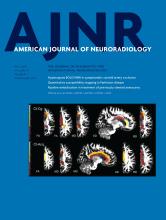Abstract
BACKGROUND AND PURPOSE: A key factor in predicting recurrent ischemic episodes in patients with carotid artery occlusion is the presence of hemodynamic impairment. There is, however, no consensus on how to best assess this risk in terms of imaging modalities or thresholds used. Here we investigated whether a predefined threshold of hemispheric asymmetry in hypercapnia fMRI predicts recurrent symptoms in patients with carotid artery occlusion.
MATERIALS AND METHODS: We studied 23 patients (2 women) with a mean age of 67.5 ± 9 years. Patients were assessed for recurrent ischemic events until lost to follow-up, study end, death, or recurrent ischemic event. Hypercapnia fMRI was used to assess the cerebrovascular reserve and quantify the percentage signal change in GM in the MCA territory and the hemispheric asymmetry index. Kaplan-Meier survival analysis and log-rank tests were performed to assess differences between patients with normal or abnormal hemispheric indices.
RESULTS: The median follow-up was 20 months. During this period, 8 patients experienced recurrent events, and 15 did not. The percentage signal change in GM in the MCA territory was significantly decreased in those patients with recurrent events compared with those without (2.39 ± 0.22 versus 2.70 ± 0.42, P = .032). The normal hemispheric index predicted event-free survival during follow-up (median, 20 months) for both the combined outcome (recurrent events and/or death, log-rank, P = .034) and recurrent retinal or ipsilateral ischemic events only (log-rank, P = .012).
CONCLUSIONS: The hemispheric asymmetry index derived from hypercapnia fMRI showed hemodynamic impairment in more than half of the studied patients with carotid occlusion, and those patients showed a higher risk of recurrent ischemic symptoms.
ABBREVIATIONS:
- BET
- brain extraction tool
- BOLD
- blood oxygen level–dependent
- CAO
- carotid artery occlusion
- CVR
- cerebrovascular reserve
- EC-IC
- extracranial-intracranial
- ETCO2
- end-tidal carbon dioxide
- hAI
- hemispheric asymmetry index
- PSC
- percentage signal change
- © 2016 by American Journal of Neuroradiology












